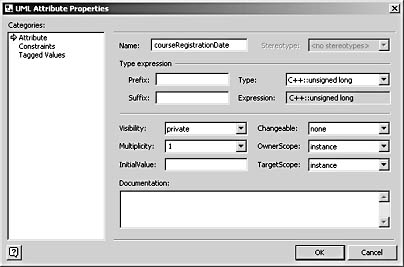Defining Common Model Properties
3 4
A model element is defined by a common set of properties that can include stereotypes, tagged values, notes, constraints, dependencies, and type/instance and type/class dichotomies. You can define the characteristics of the properties associated with each element in the UML Properties dialog box, which lists the categories associated with each common property. When you double-click an element on the drawing page or in the Model Explorer, the UML Properties dialog box for the element appears with categories of properties that you can edit. For example, you can define constraints and tagged values for an attribute of a class, as Figure 20-15 shows.

Figure 20-15. The UML Properties dialog box displays the attributes of the CourseRegistrationDate class.
InsideOut
Stereotypes, tagged values, and constraints allow you to extend UML. You can use stereotypes to create metamodel classes, tagged values to extend the attributes of the metamodel classes, and constraints to extend the metamodel semantics.
To open a UML Properties editor and add values to an element, double-click the icon that represents the element in the Model Explorer or the shape that represents the element in a diagram.
EAN: 2147483647
Pages: 211